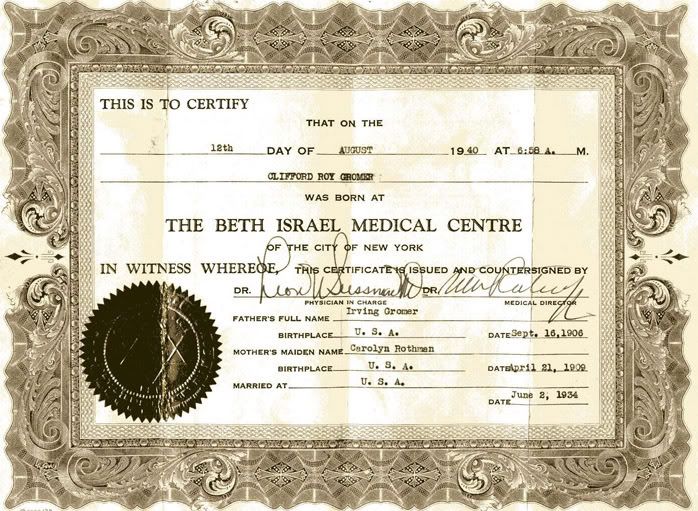
Cliff's birth certificate signed by Dr. Sussman and and an excerpt from a 6/2/1981 nytimes' article about this accomplished KV doctor
A new blood testing procedure is revolutionizing the way courts determine the identity of a child's father in paternity cases, medical and legal experts say.
The testing is known as H.L.A., for human leukocyte antigen. It identifies inherited genetic ''markers'' in the blood's white cells, allowing a laboratory to match a child with its biological father in almost all cases.
New York State recently approved the testing for courtroom use, and court officials say they expect an immediate effect on the thousands of such cases filed in Family Court each year - almost 34,000 in 1979, 60 percent of them in New York City.
''We probably won't have quite as many cases to try,'' said Judge Richard M. Palmer of Queens, president of the state's Association of Judges of the Family Court. ''The H.L.A. test will cause a lot of fathers to admit the paternity and avoid an expensive trial.''
Under state statutes or court decisions, evidence yielded by the testing has been accepted since 1979 in at least 13 other states. They are Arizona, California, Florida, Illinois, Iowa, Massachusetts, Michigan, Minnesota, New Jersey, North Carolina, Oregon, Washington and Wisconsin.
Use of the H.L.A. blood testing - originally developed in 1952 for other purposes - produced a dramatic change recently in the outcome of a paternity case in Brooklyn.
In that case, decided by Judge Frank Torres of Family Court, two New York City men - identified in court documents only as Duane, 27 years old, and Albert, 30 - had filed separate suits against an unmarried woman, Cynthia, 28. Each man claimed to be the father of her 7-year-old daughter.
Cynthia insisted the real father was Albert. But after a nonjury trial last August, Judge Torres found that the testimony of Cynthia and Albert ''was not worthy of belief.'' He tentatively concluded that Duane was the girl's real father.
However, while he prepared to write his decision, Judge Torres granted a request from Cynthia's lawyer, Richard E. Beaman of Queens, that H.L.A. testing be conducted. The testing was performed on the three adults and the baby at the New York Blood Center in Manhattan, and doctors there certified that Albert was ''most likely'' the girl's father, with a 97.3 percent level of probability. And they said Duane was absolutely not the father.
As a result, Judge Torres said in his final decision on April 7 that he had been ''forced'' to reconsider. ''In the light of scientific evidence to the contrary,'' he wrote, ''the court cannot find that Duane is the father.'' He ruled that Albert was.
Family Court judges have often had to rely solely on the credibility of witnesses. Until this year, and to the disadvantage of women claimants, blood test results in paternity cases in New York could be introduced as evidence only if they showed that the man being tested had been excluded as the father.
That was because the basic red-cell blood tests most often used by laboratories until recently were deemed generally accurate to show that someone was not a child's father, but not accurate enough to prove that someone was.
Dr. Fred H. Allen Jr. and Dr. Leon N. Sussman, researchers at the New York Blood Center, say that when used in conjunction with the traditional red-cell blood grouping tests, the H.L.A. testing can now yield ''negative'' evidence ruling out 99.9 percent of falsely accused men. Until very recently, the best exclusion rate was 65 to 70 percent, they report.
Use of the H.L.A. testing also yields strong ''positive'' evidence - previously unavailable - of ''plausibility of paternity.'' It indicates with a high degree of certainty that a man fathered a child in about 95 percent of the cases in which the alleged father is the real father.
When H.L.A. testing does not exclude a man as the father, a statistical formula is applied that takes into account the prevalence of certain genetic traits in the population groups to which the mother, child and alleged father belong. The computation results in a probability, usually greater than 95 percent, that the man is in fact the father, according to Dr. Allen and Dr. Sussman.

No comments:
Post a Comment